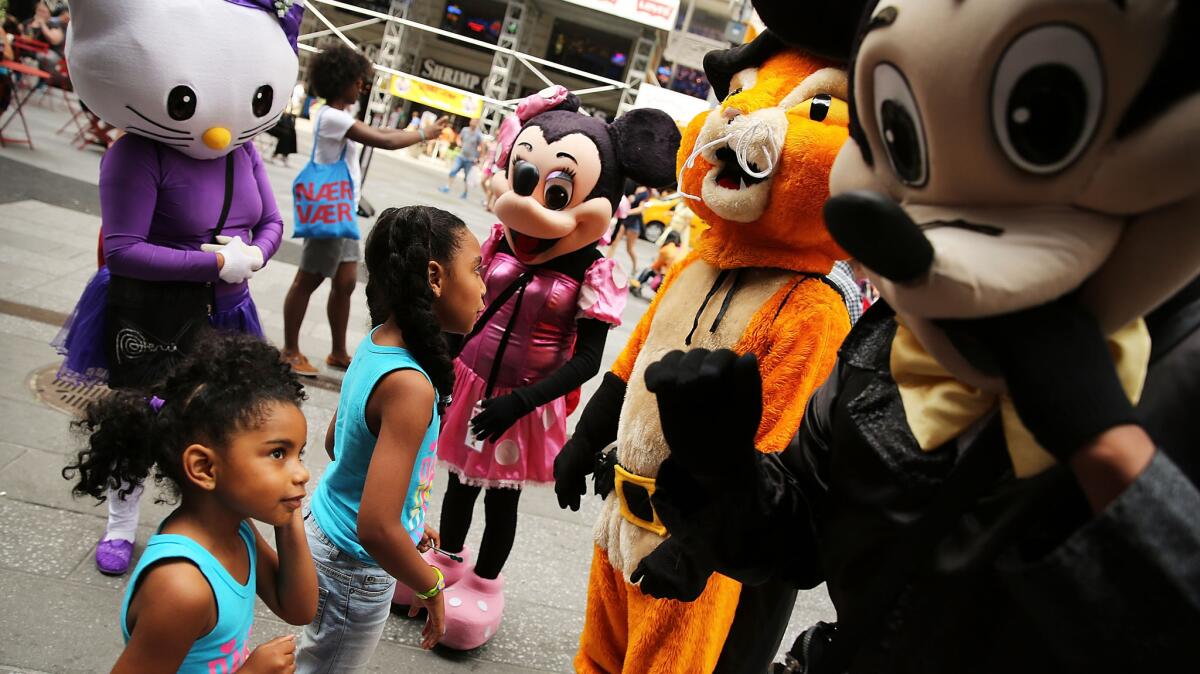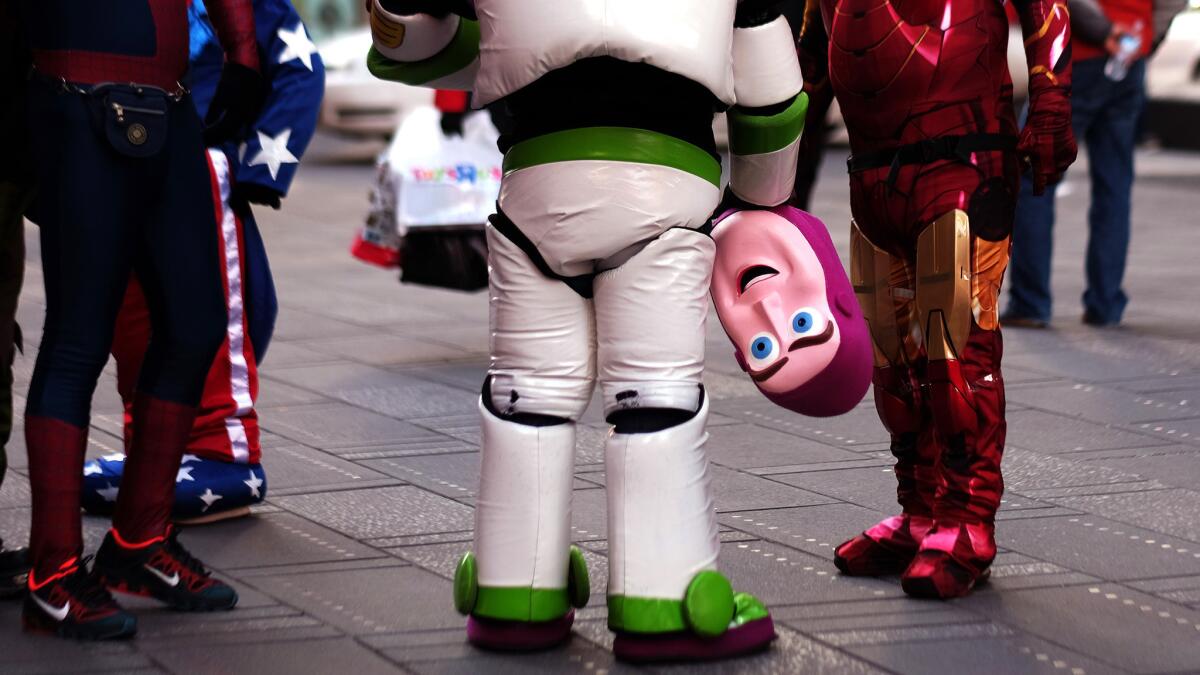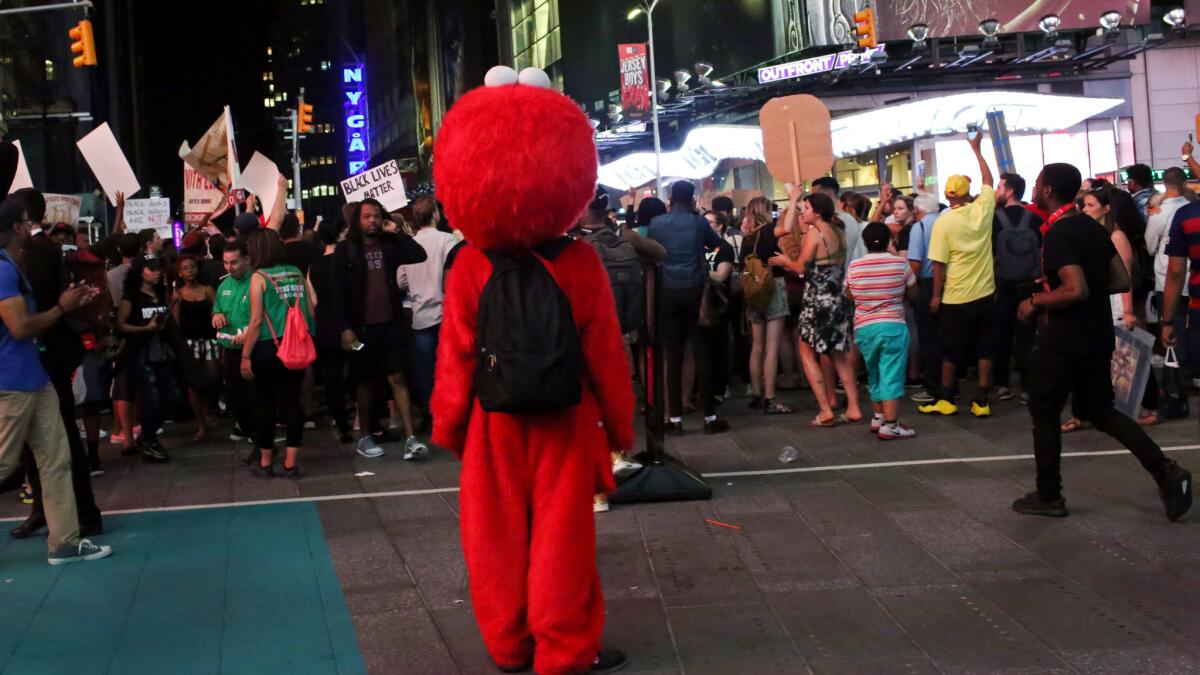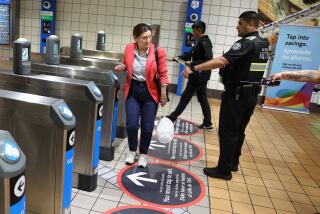After years of bad behavior, the costumed characters of New York’s Times Square no longer roam free

- Share via
Reporting from New York City — Spider-Man, a.k.a. Jeremiah Martinez, 27, recalled the good old days, before June 21, when he had the run of Times Square. He had favorite spots where he climbed street signs to show off his Spidey-like abilities for tourists, hoping they would pose with him for photos in exchange for tips.
On a recent sweltering weekday afternoon, the only thing Martinez could climb was a waist-high planter on the edge of one of eight designated “activity zones,” where he and the other costumed characters who once roamed Times Square are now corralled.
Martinez said he was resigned to the new order of the “Crossroads of the World,” though he laments his receding tips (down from $200 a day to about $80) and the enjoyment he once found working the whole square.
“It takes away some of the extra fun, but we’re dealing with it,” said Martinez, who said he’s making up the lost income by booking more children’s parties.

The city devised the activity zones after years of complaints about aggressive demands for tips and other bad behavior by some of the costumed characters.
“It was becoming a black eye for New York,” said City Councilman Daniel Garodnick (D-Manhattan), who co-authored legislation that gave the city’s Department of Transportation the authority to create the zones.
There was “Bad Elmo,” as the New York tabloids called him, charged with disorderly conduct for yelling anti-Semitic rants and a costumed Spider-Man (not Martinez) arrested for punching a police officer. There were allegations of groping and aggressive hustles for tips, usually involving tourists who did not realize that posing with Cookie Monster or Mickey was the beginning of a cash transaction.
So starting the first day of summer, the street characters were confined to the new zones — 10-foot-by-50-foot rectangles marked off with teal-colored paint on the pavement of pedestrian plazas between West 42nd and West 47th streets, where Broadway and Seventh Avenue crisscross.
It is a small stab at taming Times Square, the glittery, Technicolored public space that is a must-see for tourists and an important thoroughfare for residents and commuters.
Between 350,000 and 450,000 pedestrians pass through it daily, according to the Times Square Alliance, a business improvement group. The cars, taxis, buses, hawkers selling tickets for bus tours and comedy shows and the contingent of costumed characters just add to the shifting mass.

Dressed in his red and blue polyester outfit, Martinez was joined in an activity zone by a Smurf, two Minnie Mouses, a gowned and face-painted Statue of Liberty on stilts, Elmo, Mario (of video game fame), two Power Rangers and Woody from “Toy Story.”
“Hey lady, come take a photo,” yelled a Power Ranger, his costume-clad feet placed carefully on the zone’s painted border.
Tourists streamed by in one of the new “pedestrian flow zones” that are part of the new organizational plan, some glancing curiously at the spectacle. Some take photos from afar. Only a few actually enter the zone.
The characters complain that it get overly crowded in their confinement. And several times, Martinez said, break-dancers have squeezed in, taking up the coveted perimeter spots.
Business also suffers when Martinez and his partner — 25-year-old Anthony Rosa, who dresses as Spider-Man’s enemy Venom — have to stand next to the “desnudas,” topless women wearing body paint. They also pose for tips.
Rosa said the nearly naked women scare off families with children — the target tourists for the costumed characters. “Now we have to step to the side so that a butt isn’t in the way,” he said.
Historically, Times Square always has had an edge. In the 1970s and ‘80s, it was a seedy streetscape filled with porn parlors, drug dealers and dive bars. The area got a cleanup in the 1990s under then-Mayor Rudolph Giuliani, who ran the city on a law-and-order agenda.
Now the square has evolved into a glitzy, Disney-fied stage for huge, video billboards and chain retailers and restaurants such as Bubba Gump Shrimp Co., H&M and American Eagle Outfitters.
Yet, with the costumed characters, painted topless women and ticket hawkers, a bit of grit remains. Officials said a desire to respect the character of Times Square was why they set limitations rather than bar hawkers and street performers altogether.
“Quirky is fine. Creepy is not,” said Tim Tompkins, president of the Times Square Alliance, which helped draft the new zone regulations.
Ryan Russo, the DOT’s deputy commissioner for transportation, planning and management, said negative experiences were outnumbering positive ones.
“In great public spaces you want to have performances, things to look at and to do, but there was a sense that the balance had gotten out of whack,” Russo said.
But creating zones for certain activities has raised concerns among some 1st Amendment experts like Norman Siegel, an attorney who was the longtime director of the New York Civil Liberties Union.
“What the city of New York is creating is a no-free-expression-zone and of all places to create that zone, in the quintessential public space which is Times Square,” Siegel said in an interview.
Siegel said three or four people have court dates in early September on summons that they violated the zone regulations. Siegel said he would wait to see what happens at the hearings before deciding whether to bring a court challenge. Violations carry penalties of up to $500 in fines or possible jail time for repeat offenses.
Tompkins said legal ramifications had been carefully evaluated. “There began to be this revelation that this wasn’t artistic expression, it was commercial activity,” he said. “This is vending on the street where somebody is selling pictures in a public space where the city has a right to regulate it.”
Two blocks north of Spider-Man and friends, the most famous of Times Square’s characters, the Naked Cowboy, strummed his guitar in another activity zone. Wearing his minimalist costume of cowboy boots and hat and white underwear, Robert Burck accommodated tourists who leaned into his toned torso for photos.
Burck, who has been working Times Square for more than 18 years, said his business has been unaffected, still bringing in $500 to $600 a day in tips.
He has noticed, however, an unexpected new sense of professionalism.
“Now when I get off the subway, I know I’m going to work,” Burck said. “I’m in the box.”
Vera Haller is a special correspondent
ALSO
Mr. Incredible convicted in Hollywood Boulevard brawl with Batgirl
Want to play Superman on Hollywood Boulevard? You might need a pass for that
More to Read
Sign up for Essential California
The most important California stories and recommendations in your inbox every morning.
You may occasionally receive promotional content from the Los Angeles Times.










